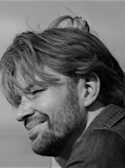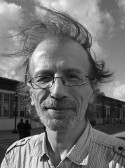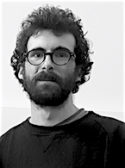Coming soon…
Category: team_members
Raphaëlle Kerbrat
Coming soon…
Samuel Bianchini
Samuel Bianchini

Samuel Bianchini lives and works in Paris. He shows regularly in France and abroad. Exhibitions have included institutions such as Art Basel, Institut français de Tokyo, Stuk Art Center (Leuven, Belgium), Centre Georges Pompidou in Paris, Deutsches Hygiene-Museum in Dresden, National Museum of Contemporary Art in Athens, Jeu de Paume in Paris, Laboratoria in Moscow, Jozsa Gallery in Brussels, Thessaloniki Biennale of Contemporary Art, Centre pour l’image contemporaine of Geneva, Rennes Biennale, Nuit Blanche in Paris, space_imA and Duck-Won Gallery in Seoul, Villa Arson in Nice, La Ménagerie de verre in Paris, Ateneo de Yucatán Museum of Contemporary Art in Mexico City, Cité des Sciences et de l’Industrie in Paris, Zentrum für Kunst und Medientechnologie (ZKM) in Karlsruhe, Musée d’Art Moderne de la Ville de Paris.
His work investigates the impact of technology on modes of representation, on our new forms of aesthetic experiences and our socio-political organizations. To bring his projects to fruition, he collaborates with scientists and technology research centers such as the Centre de Recherche en Informatique du Cnam (Conservatoire National des Arts et Métiers in Paris), Orange Labs, the Limsi-CNRS (Laboratoire pour la mécanique et les sciences de l’ingénieur, Orsay), and IEMN-CNRS (Institut d’Électronique de Microélectronique et de Nanotechnologie, Lille-Valenciennes), CEA (French Atomic Energy Commission, Saclay). In tight correlation with his artistic practice, Samuel Bianchini has undertaken theoretical work that has been published by the Centre Pompidou, Jean-Michel Place, MIT Press, Analogues, Burozoïque, Hermes and Les presses du réel.
Born in Nancy in 1971, he studied art through several different channels: beaux-arts (postgraduate program at École Régionale des Beaux-Arts de Nantes), decorative arts (École Nationale Supérieure des Arts Décoratifs, Paris), applied arts (École Nationale Supérieure des Arts Appliqués et des Métiers d’Art, Paris), engineering (CNAM, Conservatoire National des Arts et Métiers, Paris), and visual arts (Université Paris 1 Panthéon-Sorbonne).
After defending his doctoral thesis with a presentation and solo show at the Palais de Tokyo, he is today Associate Professor at the École Nationale Supérieure des Arts Décoratifs (Ensad, Paris), where he is the head of the research group Reflective Interaction, on Interactive and Performative Installations.
He has just published a book with Emanuele Quinz, called “Behavioral Objects” for Sternberg Press: http://www.sternberg-press.com
And he’s now finishing a collective book, with Erik Verhagen, called “Practicable. From Participation to Interaction in Contemporary Art” for MIT Press:
Samuel Bianchini is represented by Ilan Engel Gallery (Paris) – http://www.ilanengelgallery.com
and works, for his art publications, with mfc-michèle didier (Brussels, Paris) – http://www.micheledidier.com
Website : http://www.dispotheque.org
Filipe Pais
Filipe Pais

Filipe Pais, is a researcher, educator and curator living between London and Paris.
He has been particularly interested by the ways contemporary art and design movements inquire technological agendas, dealing with issues such as transparency, blackboxing, behaviour, play, dematerialization, flow, immersion, algorithmic governance, ecology and life after google.
He is a Research Associate at the Reflective Interaction Group from EnsadLab (the laboratory of EnsAD – École Nationale Supérieure des Arts Décoratifs, Paris) and he teaches in the fields of art, design and games at Noroff University in Norway, at Parsons School of Design in Paris, at Royal College of Art and at the London College of Communication (UAL) in London.
His doctoral research entitled Experience and Meaning-making Process in Interactive Arts – The influence of play and aesthetic distance in interactive art encounters (UT Austin Portugal, FEUP, University of Porto), explores the aesthetics of play in art experience. He was a Post-Doctoral Researcher in the project The Behavior of Things (EnsadLab and University Paris 8) exploring the notion of behaviour in objects. He was also a student of SPEAP, a Master of Arts and Politics conducted by Bruno Latour and Valérie Pihet at Sciences Po, Paris.
He has curated the exhibitions Playmode (Maat, Lisbon, 2019), From Bits to Paper (Le Shadok, Strasbourg, 2016) and Re-enter (CPAI, Lisbon, 2012). Some of his art and design projects have been presented in several group shows around Europe.
www.filipepais.com
Florent Levillain
Florent Levillain

Florent Levillain is a researcher in cognitive psychology at CHArt-LUTIN Userlab. During his thesis, he studied mental imagery and the understanding of dynamic scenes, conducting research both at the International School for Advanced Studies (Trieste, Italy) and at the Paris 8 Saint Denis University. After a postdoctoral fellowship at the Johns Hopkins University where he examined the limitations of short-term memory as well as the perception of causal relationships, Florent Levillain resumed an investigation of the interpretation of action. What are the motion cues that enable an event to be perceived? Which cognitive systems contribute to the spontaneous understanding of behavior in terms of intentional actions? These questions are brought up in the context of a collaboration with the Diip Ensadlab at The Ecole Nationale Supérieure des Arts Décoratifs in Paris.
Olivain Porry
Olivain Porry

Born in Fort-de-France (972) in 1990, Olivain Porry has graduated with honors from the Fine art school of Nantes in 2016 and is now a student-researcher at the “Reflective interaction” research program from EnsadLab. Before including an important usage of computer science his artistic practice was firstly oriented to painting. His works, which include generative processes, approach the notions of reality, artificiality and perception while being interested in communication networks and machine interaction.
Website: http://olivain.art//






